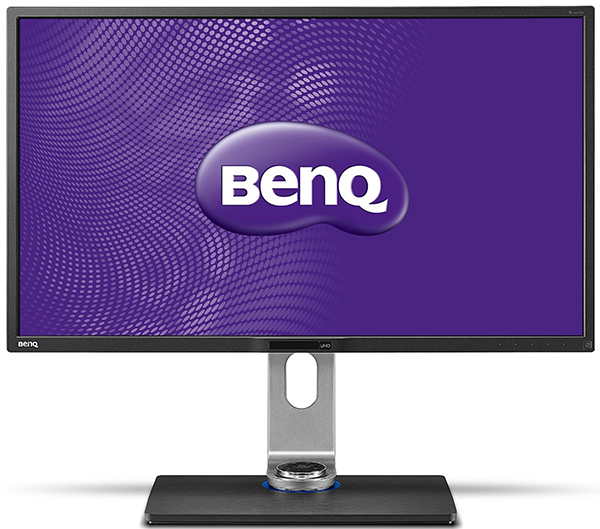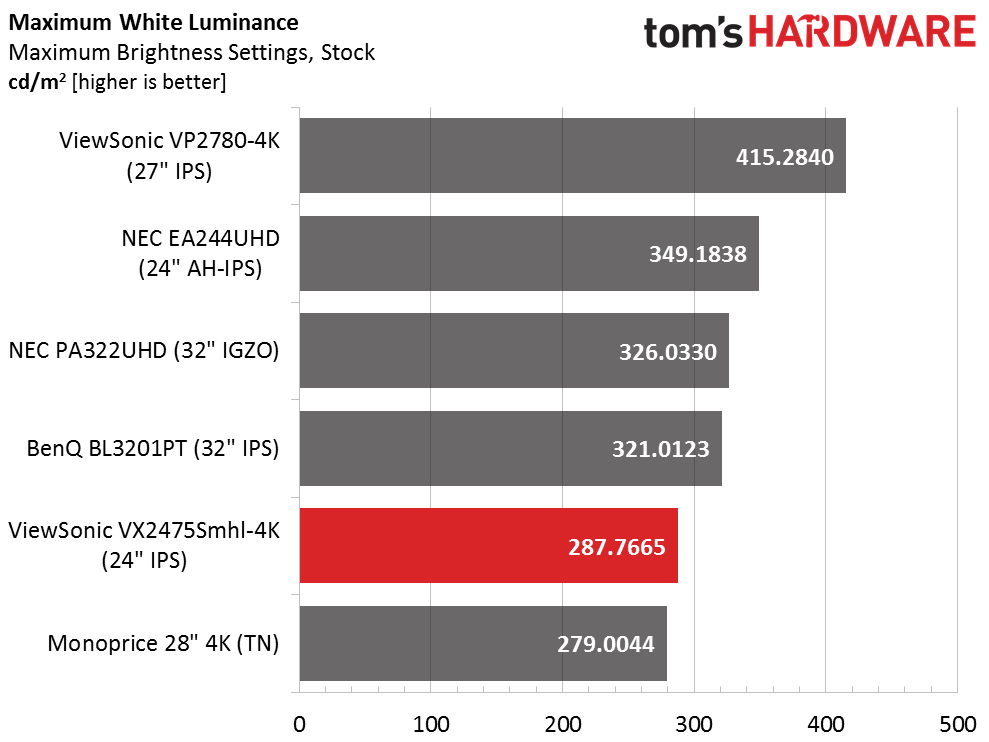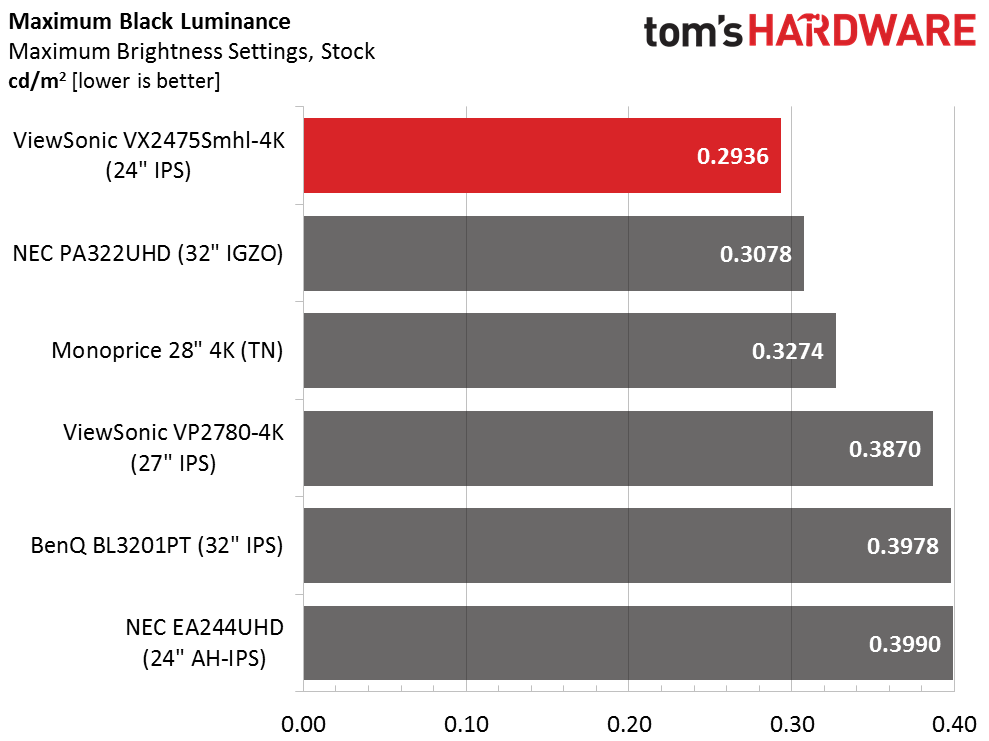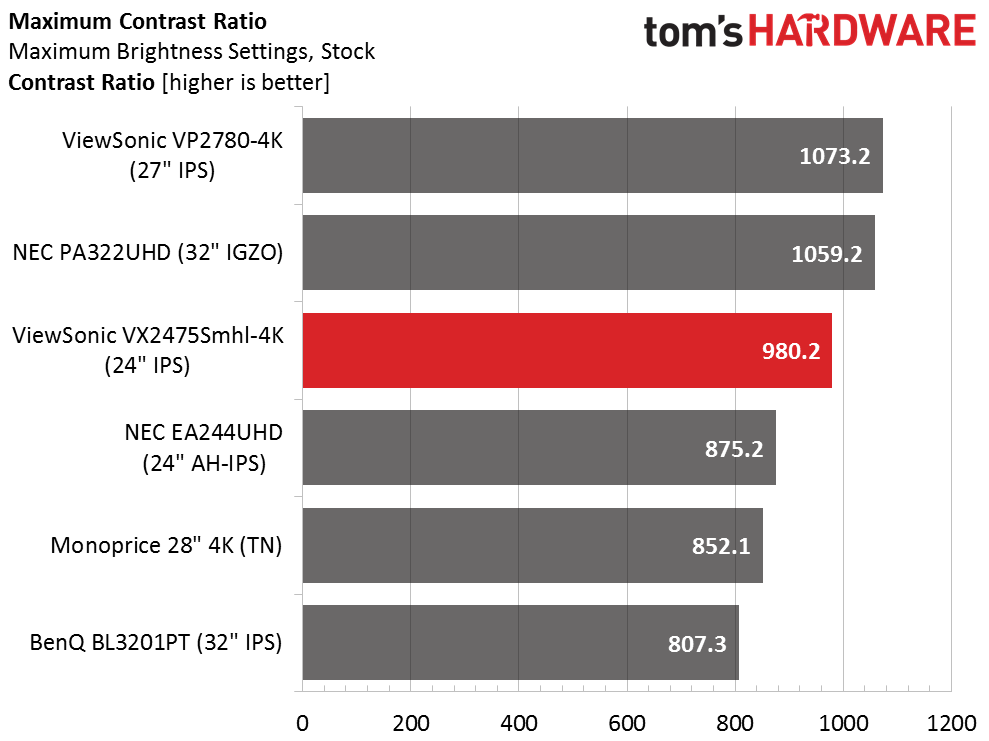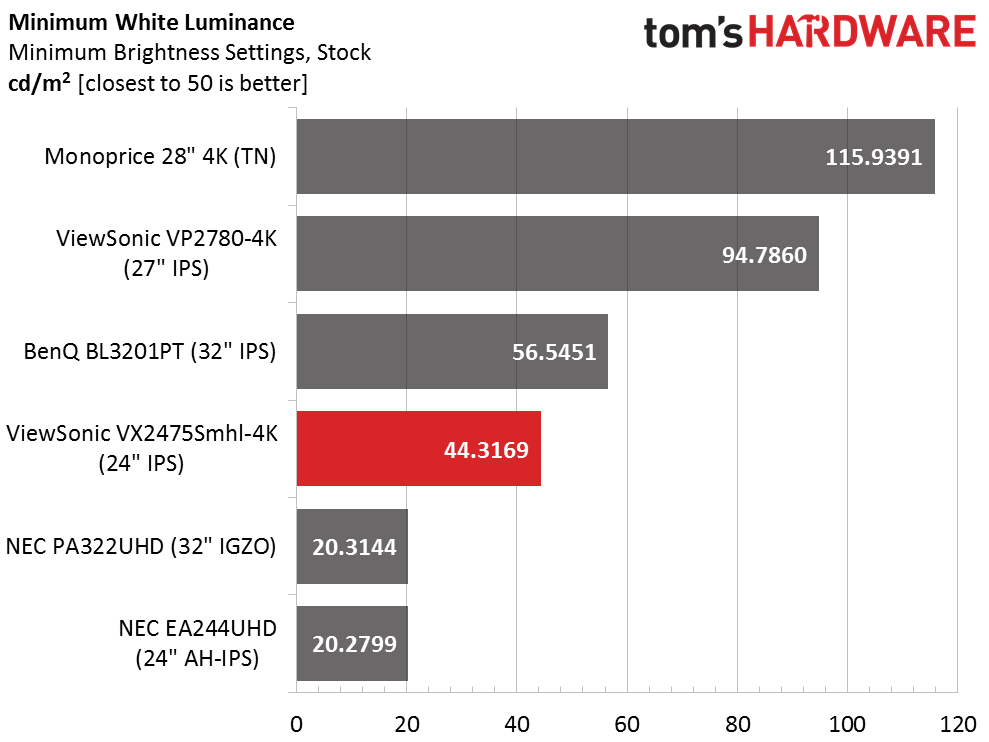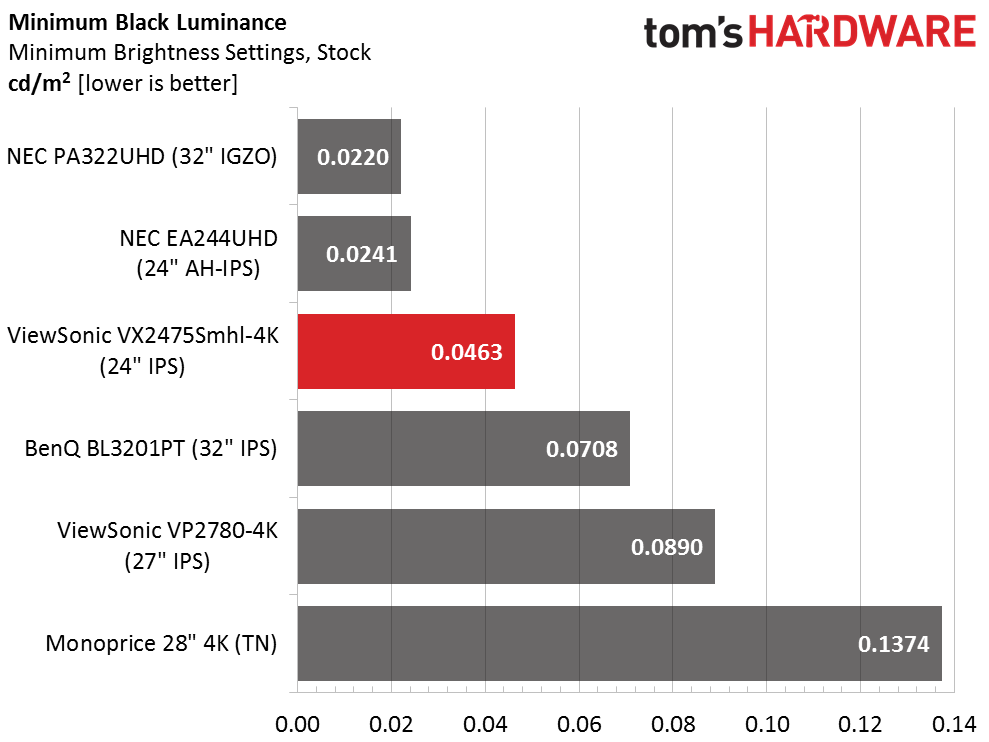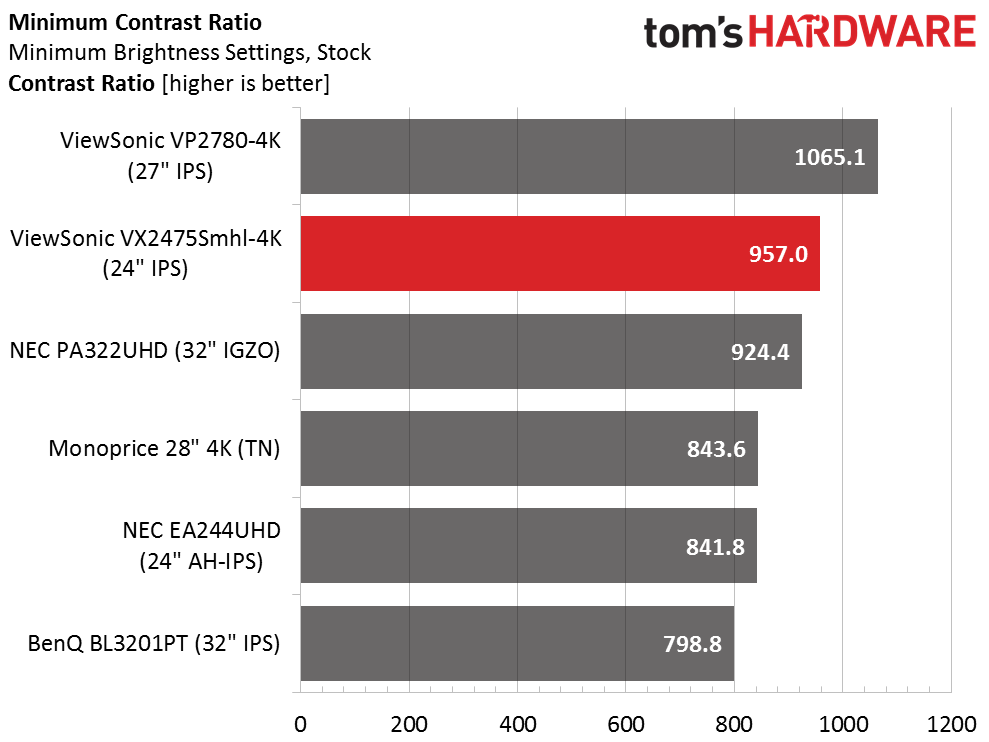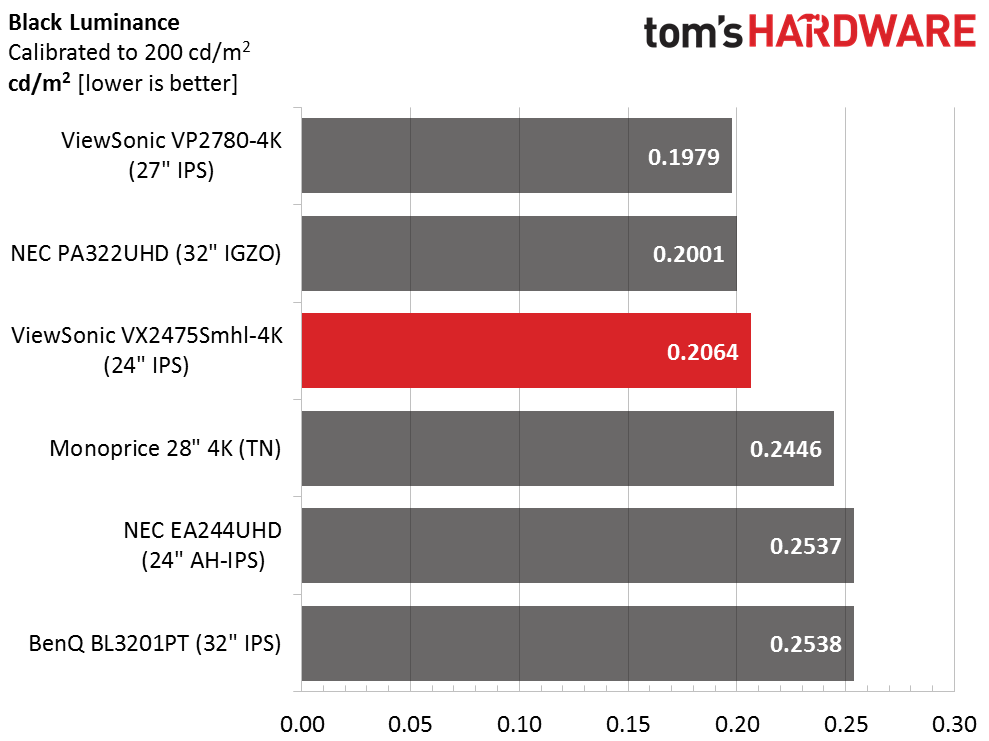ViewSonic VX2475Smhl-4K 24-Inch UHD Monitor Review
ViewSonic's new VX2475Smhl-4K is a 24-inch IPS panel that's currently one of the least expensive Ultra HD monitors available. Today we run it through our lab and hands-on tests.
Why you can trust Tom's Hardware
Brightness And Contrast
To read about our monitor tests in-depth, please check out Display Testing Explained: How We Test Monitors and TVs. Brightness and Contrast testing is covered on page two.
Uncalibrated – Maximum Backlight Level
We've seen Ultra HD monitors in four distinct categories -- 32-inch IGZO/IPS, 28-inch TN, 27-inch IPS and 24-inch IPS. All are represented in our comparison group today. From ViewSonic we have the VP2780-4K, NEC brings the EA244UHD and PA322UHD units, BenQ offers the BL3201PT and Monoprice covers TN tech with its 28-inch CrystalPro 4K.
ViewSonic claims 300cd/m2 for the VX2475Smhl-4K, but our sample came up a bit short at 287.7665cd/m2. That's not too far off but most monitors of any resolution are brighter. Still, unless you need to use the display in sunlight, there's more than enough output for either productivity or gaming.
Until we get to measure an Ultra HD VA panel, we won't see superlative black levels here. ViewSonic does take the prize in today's group however, with an excellent .2936cd/m2 measurement.
Max contrast is right in the middle of the pack at 980.2 to 1. Ideally, we'd like to see a ratio over 1000:1, but the VX comes pretty close. ViewSonic's 27-inch UHD display is the winner here. The top three screens are fairly typical of modern TN and IPS monitors. Only VA promises significantly higher contrast from LCD technology.
Uncalibrated – Minimum Backlight Level
The VX2475Smhl-4K's backlight drops to a near-ideal 44.3169cd/m2 at its minimum setting. To bring it up to 50cd/m2, set the slider on level three. You can see NEC's usual low-output setting of around 20cd/m2 for the PA322UHD and EA244UHD. Even in total darkness it's hard to make out fine detail when the monitor's peak white level is that low.
The two NECs have an unfair advantage in this test due to their dim backlights. The VX2475Smhl-4K's is low as well, which accounts for its third-place finish. But overall, contrast appears to be fairly consistent at all backlight levels.
Get Tom's Hardware's best news and in-depth reviews, straight to your inbox.
Minimum contrast takes a small hit when the backlight is at its minimum. It's only off by 2.3 percent though, which is imperceptible to the naked eye. The performance we're seeing so far is pretty much the same as other IPS monitors of all resolutions. The fact that this one is Ultra HD makes no difference in these tests.
After Calibration to 200cd/m2
The VX2475Smhl-4K stays in the upper tier for the calibrated black level test. Even though we had to drop the contrast control one click and lower the red and green levels, contrast has not suffered a bit.
The calibrated contrast result is nearly identical to the uncalibrated one. Considering the improvement in color accuracy, we think the adjustments are well worth making. If you don't have access to a color meter, try our settings from the previous page.
ANSI Contrast Ratio
A tiny bit of extra brightness down the left side of our sample reduces the ANSI result by six percent. This is a minor flaw and one you won't see in actual content. As you'll see later, overall screen uniformity is quite good. The VX2475Smhl-4K provides good contrast at all brightness levels and in all types of real-world material. We can't imagine anyone being dissatisfied with its image.
Current page: Brightness And Contrast
Prev Page OSD Setup And Calibration Next Page Grayscale Tracking And Gamma Response
Christian Eberle is a Contributing Editor for Tom's Hardware US. He's a veteran reviewer of A/V equipment, specializing in monitors. Christian began his obsession with tech when he built his first PC in 1991, a 286 running DOS 3.0 at a blazing 12MHz. In 2006, he undertook training from the Imaging Science Foundation in video calibration and testing and thus started a passion for precise imaging that persists to this day. He is also a professional musician with a degree from the New England Conservatory as a classical bassoonist which he used to good effect as a performer with the West Point Army Band from 1987 to 2013. He enjoys watching movies and listening to high-end audio in his custom-built home theater and can be seen riding trails near his home on a race-ready ICE VTX recumbent trike. Christian enjoys the endless summer in Florida where he lives with his wife and Chihuahua and plays with orchestras around the state.
-
JeanLuc The pixel density of a 4K screen is about the same as a high end 1080p smart phone, the picture quality of this must be stunning.Reply -
xenol ReplyThe pixel density of a 4K screen is about the same as a high end 1080p smart phone, the picture quality of this must be stunning.
The monitor is half that, compared against a 6" phone. But at the viewing distances of a monitor, it may as well be effectively greater. -
DisplayJunkie "nicely styled with a gloss-black bezel"Reply
Are you kidding me? Nicely styled? NO. Glossy black plastics are COMPLETE CRAP. They REFLECT the damn displayed image! This is ESPECIALLY horrible when it's used on bezels, it is EXTREMELY annoying.
And glossy black plastics look terribly cheap.
Not to mention black bezels reduces the perceived contrast ratio. Matte grays are the correct choice.
Why do monitor manufacturers keep doing this?
"Just" because of that, this monitor is immediately disqualified from my consideration.
-
xenol Reply24" UHD monitor for gaming? Nope. Just nope. It's too small for me, I'm getting old.
You can think of it this way: you no longer have to deal with anti-aliasing of any kind!
But then again 4K with no AA may as well be the same as 1080p with 4xMSAA (only not since MSAA is much cheaper than 4K still) -
nitrium I often wonder what the scalers are like in these things, i.e. if you run a resolution lower than native - something you may potentially be forced to do to get a playable framerate in gaming for example. Does it look absolute rubbish? How does 1080p look on these screens compared to 1080p on a screen with that as native resolution? Does it generally look better, worse or roughly the same? Are all scalers created equal? Would be very interested to read about this in future articles.Reply -
picture_perfect Here we go again.The best graphics card today will average 40 fps at this resolution. Check any current game. That means an awful gaming experience with judder, blur and lag. Scaling resolution down degrades picture / adds lag. So for gaming I will say NO.Reply
